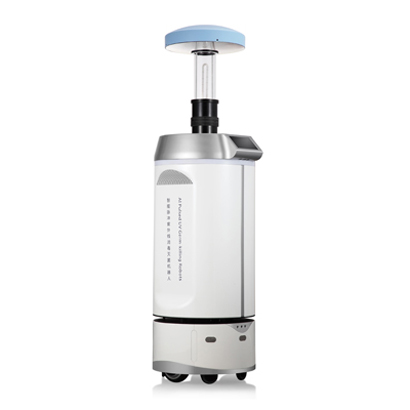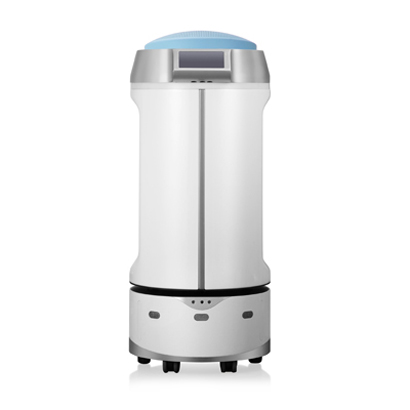Robot Pulsed Light Disinfection: Functionality and Applications
2022-04-28 by hqt

The search for an efficient and cost-effective solution to contain the corona virus is on the global political agenda. In addition to conventional methods such as disinfectant spray, washing your hands and wearing a face mask, one approach in particular is causing a lot of excitement: robot pulsed light disinfection.
Can it really be that easy to take effective action against the SARS-CoV-2 pathogen with the help of sunbeams or artificially generated UV radiation? Can you germ-free people and machines with ultraviolet light? Before you panic buy disinfectant sticks, read here what science has to say about it.
Robot pulsed light disinfection: Functionality and Applications
UV-C light actually surrounds us permanently, at least when the filtering effect of the ozone layer decreases again. Because UV-C light, i.e. short-wave ultraviolet light with a wavelength of 280-100 nm, is delivered to us free of charge by the sun. It is a light that has a strong germicidal effect and is therefore also used in various areas of our lives where sterility plays a role.
What is a robot pulsed light disinfection?
In principle, robot pulsed light disinfection is an automated robot which disinfects surfaces within 5 minutes. Furthermore, it provides an entire automatic system that doesn’t require manual labour. They have Alstrike system that comprehensively kills harmful germs. The ideal value for the effective short-wave radiation for this is 200-315 nm.
How does a UV-C robot work?
The robot pulsed light disinfection provides ultra-fast disinfection energy and thus proves a fairly high degree of utilization. The effect of the light is highly bactericidal. Microorganisms, fungal spores, yeasts and above all viruses are destroyed very quickly and thoroughly and cannot develop any resistance. UV-C light differs from other types of UV light on the one hand by its wavelength and on the other hand by its lack of visibility.
Microorganisms are killed by the light penetrating their cell walls and destroying the genetic material. This succeeds without harm to humans, since the cell walls of bacteria and viruses are thinner than human cells.
Areas of application of the UV-C Light
Air sterilization
The benefits of robot pulsed light disinfection are very diverse. And more and more areas where UV light disinfection plays a role are being conquered. Air disinfection plays a key role here. The time of the corona pandemic shows how important it is to be able to breathe sterile, unpolluted air.
Our air is permanently enriched with microorganisms and some of them can harm us and make us ill. Robot pulsed light disinfection could make a significant contribution to disinfecting the air. In the USA, this method of air disinfection is already being practiced on a large scale, with rooms in which there are normally many people using these robots. Furthermore, this device is best for health care facilities, i.e. hospitals and clinics,
Why do we need robot pulsed light disinfection?
In our latitudes, the full benefits of this light have not yet been fully discovered. Although hospitals and other health facilities need disinfection robot in greater number but still people opt less effective chemical manual disinfection. However, there is great potential for ways to better protect people against viruses – especially against the aggressive flu viruses.
Surface sterilization with robot pulsed light disinfection
But harmful microorganisms are not only found in the air. They like to settle on surfaces made of solid materials in particular and, in the worst case; can become a hotspot for disease and infection. Materials that are used in the food sector are particularly affected.
Municipal waterworks are also increasingly relying on the sterilization of water using UV-C light. During water sterilization, harmful bacteria are destroyed and the water is easy to treat as drinking water.
In the analogue world, the coronavirus has made toilet paper a popular item to buy. Something else is being advertised online: robot pulsed light disinfection for disinfecting surfaces. Sure: It has long been proven that certain areas of UV light can destroy germs. This is used, for example, in hospital hygiene.
How robot does pulsed light disinfection kill germs and viruses?
Germs don’t like the sun – so far, so well known. This is one of the reasons why, for example, certain influenza viruses almost disappear seasonally. Certain parts of UV light, especially UV-C radiation, penetrate to the genetic material of bacteria, fungi or viruses and damage the DNA or RNA – mutations occur that make reproduction impossible.
Microorganisms have been “deactivated” with light in this way for around 100 years. Earlier this was done with light sources that contained chemical elements that were sensitive and (when damaged, also for humans) sometimes harmful, such as mercury. For a few years, however, LEDs have also been used in the disinfection area. It also has the advantage that they can specifically emit the part of the UV light that is most harmful to microorganisms.
US study on virus inactivation of SARS-CoV-1
The harmful effects of UV radiation are so well known – not least for us people from cancer research. Many people who are unsettled by the current pandemic in connection with SARS-CoV-2 apparently come up with the idea of using them to use strength also in the private environment. Reports from China, but also Canada from companies that produce robot pulsed light disinfection, report a strong increase in sales of disinfection robots.

The professional use of UVC Light
“UV-C light is used in the sanitation area in the food industry, for example for sanitizing surfaces that come into contact with food. Basically, we have the entire spectrum of all microorganisms occurring in the food sector on the surfaces – be it pathogenic zoonosis -pathogens or environmental germs.
The areas of application for UV-C light in industry or, of course, in health are diverse: The professional robot pulsed light disinfection minimize germs. Robots walk alone through some operating theaters and hospital rooms around the world. When they are done, the light goes out and the room is aired.

